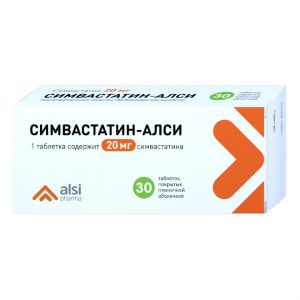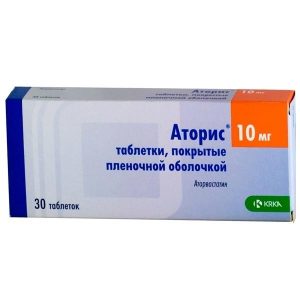Description
Latin name
Rozucard
Release form
Tablets, film-coated, light pink, oblong, biconvex, with a risk.
Packing
90 pcs.
Pharmacological action of
Rosucard – a lipid lipid statins A selective competitive inhibitor of 3-hydroxy-3-methylglutaryl coenzyme A (HMG-CoA) reductase, an enzyme that converts HMG-CoA to mevalonate, a cholesterol precursor (cholesterol)
Increases the number of low-density lipoprotein receptors spine (LDL) on the surface of hepatocytes, which leads to increased trapping and catabolism of LDL, inhibiting the synthesis of very low density lipoproteins (VLDL), reducing the total concentration of LDL and VLDL. Decreases in LDL-cholesterol concentration, high-density non-lipiprotein cholesterol (cholesterol-non-HDL), cholesterol-VLDL, total cholesterol, triglycerides (TG), TG-VLDL, apolipoprotein B (ApoV), reduces the ratio of LDL-C / HDL, total cholesterol / HDL-C Non-HDL-C / HDL-C, ApoV / Apolipoprotein A-1 (ApoA-I), increases the concentration of HDL-C and ApoA-I.
Hypolipidemic effect is directly proportional to the size of the prescribed dose. The therapeutic effect appears within 1 week after the start of therapy, after 2 weeks it reaches 90% of the maximum, by 4 weeks it reaches a maximum and after that it remains constant. Effective in adult patients with hypercholesterolemia with or without hypertriglyceridemia (regardless of race, gender or age), including patients with diabetes mellitus and familial hypercholesterolemia. In 80% of patients with type IIa and IIb hypercholesterolemia (Fredrickson classification) with an average initial concentration of LDL-C about 4.8 mmol / L while taking the drug at a dose of 10 mg, the concentration of LDL-C reaches less than 3 mmol / L. In patients with homozygous familial hypercholesterolemia, taking the drug at a dose of 20 mg and 40 mg, the average decrease in the concentration of LDL-C is 22%.
The additive effect is observed in combination with fenofibrate (in relation to a decrease in the concentration of TG and with nicotinic acid in lipid lowering doses (not less than 1 g / day) (in relation to a decrease in the concentration of HDL-C).
Indications
Primary hypercholesterolemia (type IIa according to Fredrickson), including heterozygous hereditary hypercholesterolemia or mixed (combined) hypercholesterolemia (type IIb according to Fredrickson), as an adjunct to diet and other non-medication (weight loss) and non-drug measures
Homozygous form of hereditary hypercholesterolemia and with insufficient effectiveness of diet therapy and other types of treatment, is aimed s to reduce the level of lipids (e.g., LDL apheresis) or if such treatments are not suitable patient.
Hypertriglyceridemia (type IV Fredrickson supplementation) as a diet supplement.
To slow the progression of atherosclerosis as a supplement to patients ’diet, which shows therapy to reduce the concentration of total cholesterol and cholesterol – LDL.
Prevention of major cardiovascular complications (stroke, heart attack, arterial revascularization) in adult patients without clinical signs of coronary heart disease (CHD), but with an increased risk of its development (over 50 years old for men and over 60 years old for women, increased concentration C-reactive protein ( 2 mg / l) in the presence of at least one of the additional risk factors, such as arterial hypertension, low concentration of HDL-C, smoking, family history of early onset of coronary artery disease.
Contraindications
Hypersensitivity to rosuvastatin or other components of the
preparation Diseases of the liver in the active phase or a steady increase in serum activity of “hepatic” transaminases (more than 3 times compared with the upper limit of norm) of unknown origin, liver failure (severity from 7 to 9 points on the Child-Pugh scale)
Increase in the concentration of creatinine phosphokinase (CPK) in the blood by more than 5 times compared with the upper limit of normal (VGN)
Inherited diseases such as lactose intolerance, lactase deficiency or glucose-galactose malabsorption (due to the presence of lactose)
Severe renal impairment (CC less than 30 ml / min)
Myopathy
Patients predisposed to the development of myotoxic complications
Simultaneous administration of cyclosporine
p Joint use with
HIV protease inhibitors Women of reproductive age who do not use adequate methods of contraception
Pregnancy and lactation
Age under 18 years (efficacy and safety have not been established).
Use during pregnancy and lactation
The use of Rosucard in women of reproductive age is possible only if reliable contraception methods are used and if the patient is informed about the possible risk of treatment for the fetus.
Since cholesterol and substances synthesized from cholesterol are important for fetal development, the potential risk of inhibiting HMG-CoA reductase exceeds the benefits of using the drug during pregnancy. Rosucard is contraindicated in pregnancy and lactation. If pregnancy is diagnosed during the course of drug therapy, Rosucard should be stopped immediately, and the patient should be warned of the potential risk to the fetus.
If it is necessary to use the drug during lactation, given the possibility of adverse events in infants, the issue of stopping breastfeeding should be addressed.
Composition
1 tab. – rosuvastatin calcium 10.4 mg, which corresponds to the content of rosuvastatin 10 mg.
Excipients: lactose monohydrate – 60 mg, microcrystalline cellulose – 45.4 mg, croscarmellose sodium – 1.2 mg, colloidal silicon dioxide – 600 μg, magnesium stearate – 2.4 mg.
Film composition: hypromellose 2910/5 – 2.5 mg, macrogol 6000 – 400 mcg, titanium dioxide – 325 μg, talc – 475 μg, iron dye oxide red – 13 μg.
Dosage and administration
Inside, without chewing or grinding, swallow whole, washed down with water, at any time of the day, regardless of food intake.
Before starting therapy with Rosucard, the patient should begin to follow a standard lipid-lowering diet and continue to follow it during treatment. The dose of the drug should be selected individually depending on the indications and therapeutic response, taking into account current generally accepted recommendations for target lipid levels. If it is necessary to take the drug in a dose of 5 mg, a 10 mg tablet should be divided into two parts at risk.
Recommended starting dose of Rosucard for patients starting to take the drug, or for patients transferred from other HMG-CoA reductase inhibitors, 5 or 10 mg once daily. When choosing an initial dose, one should be guided by the patient’s cholesterol content and take into account the risk of developing cardiovascular complications, and it is also necessary to assess the potential risk of side effects. If necessary, after 4 weeks the dose of the drug can be increased.
Due to the possible development of side effects when taking a dose of 40 mg compared to lower doses of the drug, the final titration to a maximum dose of 40 mg should be performed only in patients with severe hypercholesterolemia and a high risk of cardiovascular complications (especially in patients with hereditary hypercholesterolemia ), in which, when taking a dose of 20 mg, the target cholesterol level was not achieved, and which will be under medical supervision.
Patients with hepatic insufficiency
In patients with hepatic insufficiency with values on the Child-Pugh scale below 7 Rosucard dose adjustment points are not required.
Patients with renal failure
Dose adjustment is not required in patients with mild renal failure. The recommended initial dose of Rosucard is 5 mg per day.
In patients with severe renal failure (CC less than 30 ml / min), the use of Rosucard is contraindicated.
In patients with moderate renal insufficiency (CC 30 – 60 ml / min), the use of Rosucard at a dose of 40 mg per day is contraindicated.
Special Populations. Elderly
patients Dose adjustment is not required in patients over 65 years of age.
Patients with a predisposition to myopathy
The use of rosucard at a dose of 40 mg per day is contraindicated in patients with a predisposition to myopathy. When prescribing doses of 10 mg and 20 mg per day, the recommended initial dose of Rosucard for this group of patients is 5 mg per day.
Ethnic groups
When studying the pharmacokinetic parameters of rosuvastatin, an increase in the systemic concentration of the drug was observed in representatives of the Mongoloid race. This fact should be taken into account when prescribing Rosucard to patients of the Mongoloid race. When prescribing doses of 10 and 20 mg, the recommended initial dose of Rosucard for this group of patients is 5 mg per day. The use of Rosucard at a dose of 40 mg per day in representatives of the Mongoloid race is contraindicated. When appointing Rosucard with gemfibrozil, the dose should not exceed 10 mg per day.
Drug Interaction
Co-administration of rosuvastatin and cyclosporine does not affect the plasma concentration of cyclosporine, however, the effect of rosuvastatin is increased (its excretion is slowed, AUC is increased by 7-fold, C max – by 11-fold).
Erythromycin increases intestinal motility, which leads to a decrease in the effect of rosuvastatin (AUC is reduced by 20% and C max by 30%).
In patients, Vitamin K antagonists (eg, warfarin) are advised to monitor International Normalized Ratio (INR), since initiation of rosuvastatin therapy or increasing the dose of the drug may lead to an increase in INR, and cancellation or reduction of rosuvastatin may lead to a decrease in it. Gemfibrozil enhances the effect of rosuvastatin (increases Cmax and AUC by 2-fold). Concomitant administration of rosuvastatin and antacids containing aluminum and magnesium hydroxide results in a decrease in the plasma concentration of rosuvastatin by about 50%. This effect is less pronounced if antacids are administered 2 hours after taking rosuvastatin.
Co-administration of rosuvastatin and oral contraceptives increases the ethinylestradiol AUC and norgestrel AUC by 26% and 34%, respectively, that should be taken into account when selecting the dose of oral contraceptives. There are no pharmacokinetic data on the concomitant use of rosuvastatin and hormone replacement therapy, and therefore, a similar effect cannot be ruled out when using this combination.
Studies have shown that rosuvastatin is neither an inhibitor nor an inducer of cytochrome P450 isoenzymes. Rosuvastatin is a non-core substrate for these isoenzymes. No clinically relevant interaction with such drugs as fluconazole, ketoconazole and itraconazole associated with metabolism with the cytochrome P450 system was observed.
No clinically relevant interaction of rosuvastatin with digoxin or fenofibrate, Gemfibrozil, other fibrates and hypolipidemic doses of nicotinic acid (at least 1 g / day) increased the risk of myopathy when co-administered with other HMG-CoA reductase inhibitors. This may be due to the fact that they can cause myopathy even when used as monotherapy.
The combined use of rosuvastatin and ezetimibe did not alter the AUC or Cmax of both drugs.
The use of HIV protease inhibitors (human immunodeficiency virus) with rosuvastatin can significantly increase the effect of rosuvastatin. A pharmacokinetic study of the co-administration of 20 mg rosuvastatin with healthy volunteers and a combination of two HIV protease inhibitors (400 mg lopinavir / 100 mg ritonavir) resulted in approximately two and fivefold increases in AUC (0-24) and C max, respectively. Therefore, co-administration of rosuvastatin with HIV protease inhibitors is not recommended in HIV-infected patients.
Overdose
When given several daily doses, the pharmacokinetic parameters of rosuvastatin do not change.
Treatment: specificwho have no treatment, symptomatic therapy is performed to maintain the functions of vital organs and systems. Monitoring of liver function and CPF activity is required. Hemodialysis is ineffective.
Storage conditions
At a temperature not exceeding 25 oС in the original packaging.
Expiration
2 years.
Deystvuyuschee substances
rosuvastatin
dosage form
dosage form
tablets




